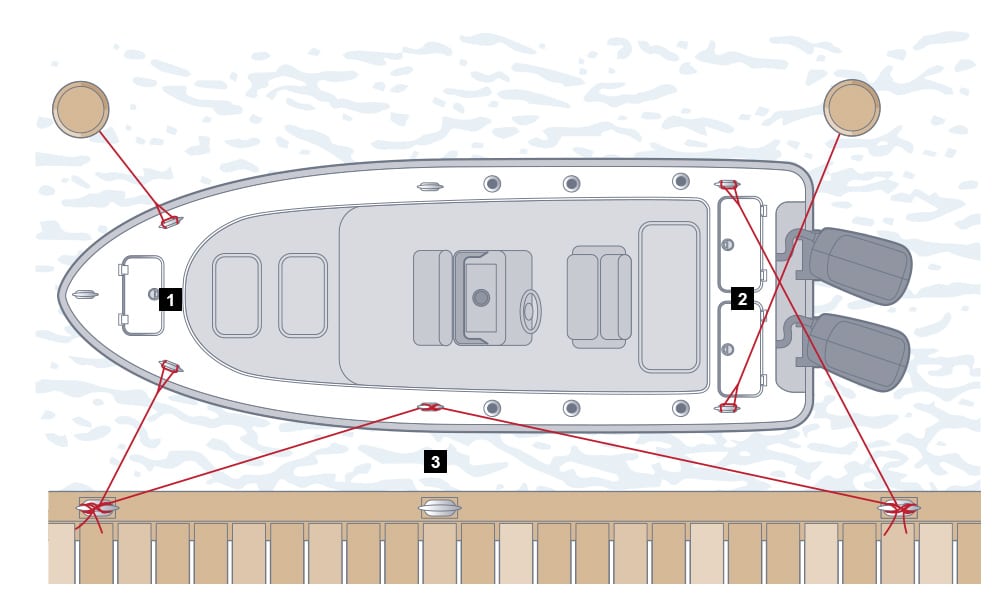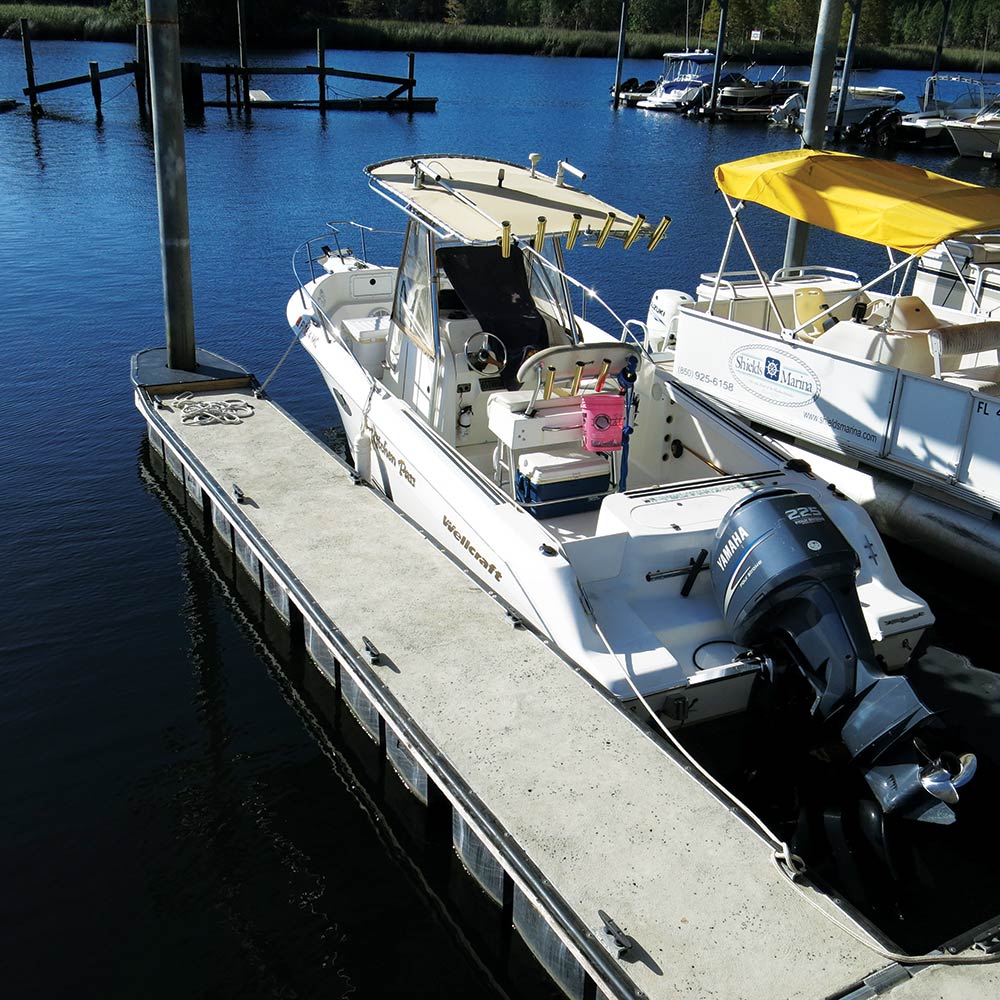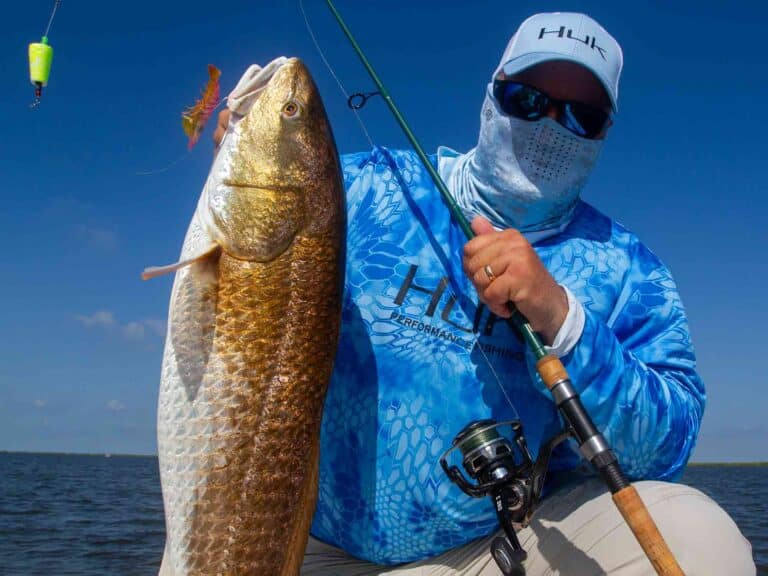
2.) Stern Lines: Cross both lines before tying them to the stern port and starboard cleats. Adjust the length to ensure they rest over the motors to prevent snags during tide fluctuations.
3.) Spring Line: When two bow and two stern lines are used, one spring line is enough to limit forward or backward movement and pull the boat close to the dock for boarding. Illustration by Tim Barker
Long before the first cast, every successful fishing trip starts with an uneventful boat launch. We’ve all witnessed (or experienced) the follies that occur.
But there are several ways to minimize hassles and eliminate mishaps. Two seasoned guides share what works best for them.
Capt. Scott Simpson, who runs a Stamas 240 Tarpon center console in Long Beach, Mississippi, also honed his boat-handling skills as a coxswain in the U.S. Coast Guard. “I usually launch the boat by myself, so I have a 30-foot-long, ¼-inch-diameter dock line with eye splices in both ends. I attach one to the starboard bow cleat, drape loops over the bow rail, and slip the other eye splice over the trailer neck.
As the boat slowly comes off the trailer, the line comes taut and stops the reverse momentum. I then wrap the line around a piling or pier support to hold the boat in place while I go park the trailer. If I have someone helping me, I walk down the pier while the other person backs the trailer down the ramp. I also cleat to the stern, hold the line in the middle and pull towards me so the boat stays parallel to the dock.”

Simpson doesn’t use a boat hook, but a pair of fenders keeps the hull off the pilings and barnacles. He splices a 6-foot line to the eye of a cylinder fender for the bow and ties it off to the rail with a bowline knot. The extra length allows for tide fluctuations. The stern or midship fender is tied to a short section of 1½-inch wooden dowel with a hole drilled in one end. Simpson inserts the dowel into a gunwale rod holder, and a stop knot allows for quick adjustments.
When leaving the boat in the water or overnight in a transient slip, Simpson has a set pattern too. “Your dock lines should be at least the length of the boat,” he says. “Overnighting requires a minimum of five lines, including two each port and starboard for the bow and stern, plus one spring line. Always tie the spring line first using figure-eight loops around the cleats. The spring line lets you pull over to the finger pier to get off, but it also keeps the boat from going too far back so the engine doesn’t hit the sea wall.
With the engine tilted up, the skeg should be no closer than 2 feet away. Note the tidal swings and leave enough scope so the boat rests in the center of the slip. It usually takes some fine-tuning to get it right. If you cross the stern lines, the ropes should rest on top of the engine cowling to prevent hang-ups. Also, be aware of fuel vents, transducers and other things that can get damaged while docking. I got into the habit of fully retracting my trim tabs so they aren’t damaged on the trailer bunks.”
Whether he’s using his 23 Shoalwater catamaran or his Wellcraft 241 bay boat, Capt. Glyn Austin also launches solo at ramps in Sebastian and Melbourne, Florida. After the boat is powered off the trailer, he idles down the dock and plants his 8-foot Power-Pole spike to temporarily hold the boat in position. He then attaches a 25-foot-long, ⅜-inch single dock line to secure the mooring. The tag end goes through the opposite eye splice before being looped over a piling. The tag end is then tied off to a boat cleat.
“A ⅜-inch braided nylon line is strong enough for my boats,” Austin says. “You can’t get as many wraps around smaller cleats with ½- or ⅝-inch lines, plus you can’t go through the middle on some. Rinse ’em down with fresh water every so often and keep ’em out of the sun, and dock lines will last the life of the boat.” During trips, he normally keeps one line attached and coiled on the bow for easy access.
Austin is considering fenders to prevent damage to the gelcoat gradually caused by rubbing against exposed bolts on dock and pier pilings, but currently, he uses neither fenders nor a boat hook because of limited storage space. Yet at most ramps, he’s able to lay the boat alongside the pilings without any problems.
Austin also uses the wind and current to his advantage when maneuvering or mooring. “I don’t fight the elements,” he says. “If it’s windy or the water is rough, I always dock on the lee side of the pier so the boat holds off. When the current is ripping, I allow for drift to line up on the trailer. If you’re methodical loading, unloading and docking doesn’t have to be a major ordeal.”
Pre-Boat Launch Checklist
• Load all gear into the boat before pulling into the ramp.
• Remove any tie-downs or transom straps.
• Remove or disengage any engine transom savers or brackets.
• Make sure the bilge plug is in.
• Disconnect the trailer lights from the tow vehicle and secure the wiring harness.
• Unhook the trailer safety chain.
• Attach all necessary dock lines and fenders for quick access.
• Turn on the battery switch.
• Put the key in the ignition.
• If necessary, tilt the engine for ramp clearance.
• Remove the bow strap once the trailer is down the ramp.









